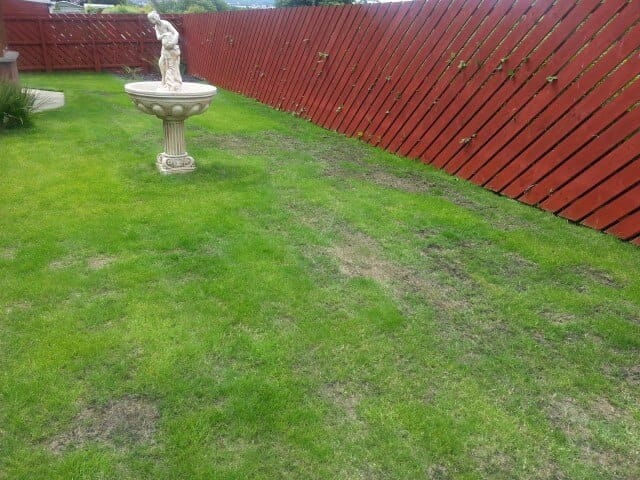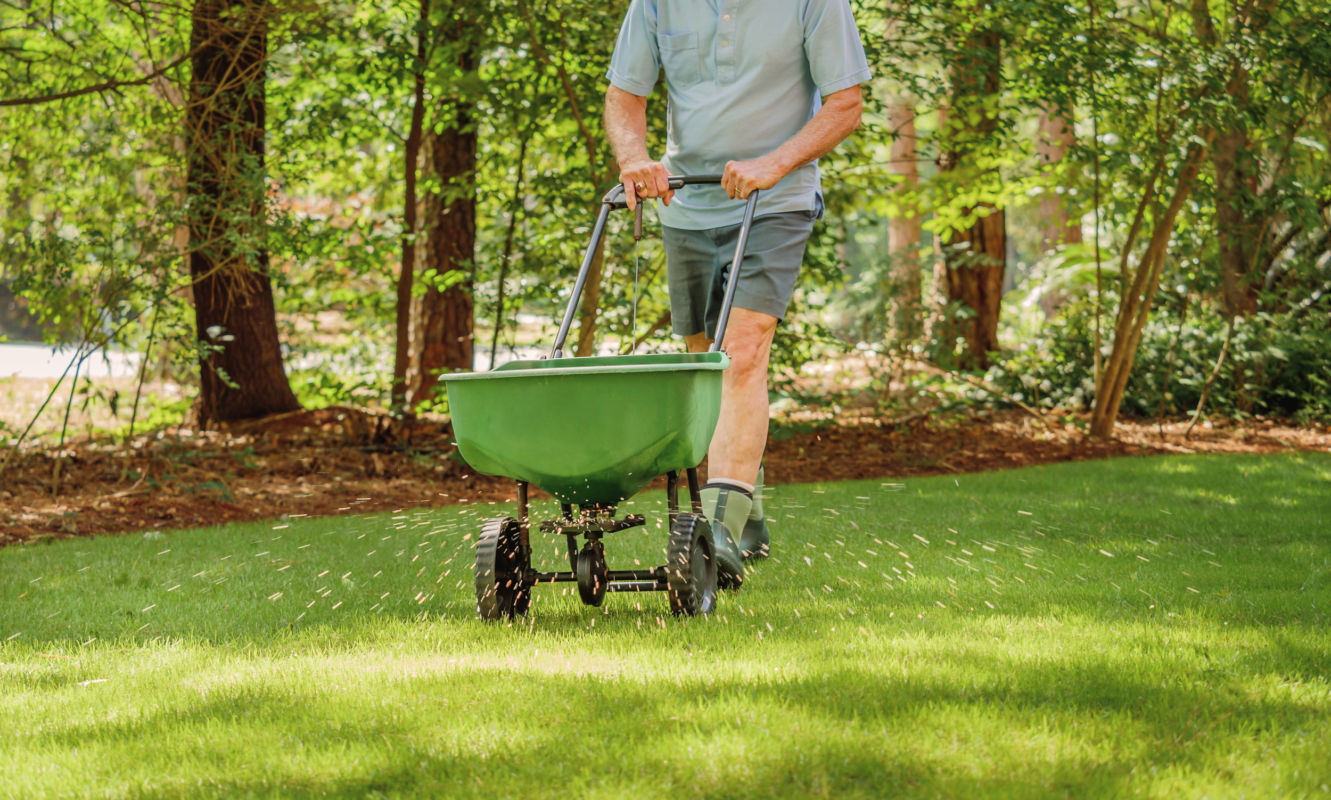Autumn and spring give us the ideal opportunity to improve a lawn by overseeding it. Here’s how to prepare your lawn for overseeding.
If your lawn is a bit thin, patchy or even bald in places. But you are gazing in envy at the grass growing at your local golf course, bowls club or public park and wondering how they get that wonderful velvety texture. This is the blog post for you.
Its highly likely that those beautiful lawns that are turning you green with envy are regularly overseeded to keep them looking good and performing well.
What is Overseeding?
Overseeding is a lawn care job that introduces extra plants into the sward without disturbing the grass that is already there.
If you were to take a walk in the countryside and get your nose down close to the grassy tracks and verges. You’d most likely notice that the grass plants are quite widely spaced. That’s Mother Nature’s not-so-secret formula for making sure that each plant has enough space, water and nutrients to support it as it grows and reproduces. And, despite you giving your lawn plenty of TLC, that’s what Mother Nature wants to do to your lawn – she wants to space those plants out.

If you want a velvety textured lawn with a thick sward and no sight of the soil beneath it, you need to override Mother Nature’s activity by adding new plants faster than she can thin them out. Overseeding is all about using the bare space between the grass plants in your lawn to grow new plants. It’s that dense population of grasses that will give you the coverage and the texture you want to see. And by filling those spaces with grass, you are of course, making it harder for weeds or moss to get established.
In a nutshell, overseeding is exactly what the name suggests. You apply seed over the top of your existing lawn. But throwing seed around won’t make it grow. You need to prepare your lawn for overseeding. And here’s how you do it.
- Remove all furniture, toys and other debris from the surface of the lawn
- Choose the right seed mix for your lawn
- Scarify to get rid of thatch
- Prepare a seedbed by scarifying, raking or aerating
- Apply seed evenly
- Ensure good seed-soil contact
What Time Of Year Is Best To Overseed?
You want to give your new grass seed the best possible chance of germinating and growing into healthy, mature plants. For that you need warm (but not hot) soil, water, sunshine, and terrific seed to soil contact. Those seeds need to germinate before they get eaten by birds and before they can start to rot.
It makes sense then that Greenkeepers prefer to overseed in late spring or early autumn.
Late spring – because there’s less risk of frost, the soil is warming up and there’s usually a decent amount of rainfall.
Early autumn – before we start getting frosts. Just like spring time, we should be getting some rain but the soil still retains some warmth from summer time. It’s a good idea to overseed while we still have a good 10 -12 hours of daylight each day. Those young plants will need sunlight so that they can photosynthesise and grow. Ideally, do your overseeding while the leaves are still firmly on the trees. And as soon as they start falling, be very vigilant at gathering them up every day. Nothing suffocates a young plant more effectively than a layer of light-excluding autumn leaves.

Overseeding is a good way to fine-tune your lawn to the conditions in your garden. This is a shade tolerant seed mix added to a lawn beneath mature trees.
Which type of seed should I buy?
If you are generally happy with your lawn’s performance, try to match the seed mix that is already there. I know that sounds like a massive task and unless you grew the lawn from seed yourself you might not know exactly what species it contains. But you will know if it is a fine lawn that can be mown really short or if it’s a family lawn that likes to be maintained at around 5cm long.
Here’s the thing though. Overseeding allows you to gradually change the properties of your lawn. Say for example you have a ryegrass mix lawn that is struggling to grow in a shaded garden. You can overseed each year with a shade tolerant grass species and gradually, your lawn will become more robust.
Perhaps you want to introduce some clover or low growing wildflowers into your lawn. Overseeding is a great way to do just that.
Take a look at my blog on choosing the right seed for your lawn.
Preparing Your Lawn For Overseeding
With your grass seed sitting nicely in a cool dry place in your shed, waiting to be sown. It’s time for you to prepare your lawn for overseeding.
As I mentioned earlier, if you just sprinkle the seed onto the surface of your lawn, there’s a good chance it won’t grow. You need to prepare a seed bed, just as you would if you were sowing any other type of seed in your garden.
But how do you prepare a seed bed without destroying the grass that’s already growing? Here’s the thing, grass seeds are tiny. Each one only needs a very small bit of ground to grow in. So what you are going to do to prepare your lawn for overseeding, is make lots and lots of tiny seedbeds in between the plants.
Don’t panic, it’s not difficult or time consuming. Here’s how I do it.
Step By Step Guide
Start by clearing the decks. Remove all furniture, toys, fallen leaves and other debris.
Mow your lawn. The shorter the grass, the easier it will be for the seeds to drop down and make contact with the soil. Remember the 1/3 rule though. You might want to reduce the mowing height over 2 or 3 cuts.
If your lawn is very ‘thatchy’, scarify. Making 2 turns with the scarifier, the second one with the blades set nice and low will straight away give you a seed bed. Alternatively, if you have a small lawn, a spring tine rake will do an excellent job of scuffing up the soil.
Aerate your lawn. A hollow tine aerator (or a garden fork) will create teeny tiny planting pockets all over your lawn. Ideal for seeds to fall in and get instant contact with the soil.
Apply your seed nice and evenly. You don’t want to be seeing thick and thin patches of grass in 6 weeks time. There will be a noticeable colour difference between those areas and you will kick yourself.
Finally, give your neighbours a good laugh by using a soft brush to gently tease those seeds down to the soil so that they can start growing.
This video on my YouTube Channel shows you just what each stage of preparing your lawn for overseeding looks like. Subscribe to my channel to learn more about every aspect of lawn care, including how to save money by making your own tools and equipment.
More Lawn Care Articles
What is the best grass seed for your lawn?
A beginners guide to renovating and ugly lawn.
Shop grass seed and other lawn care products.

